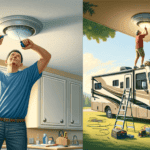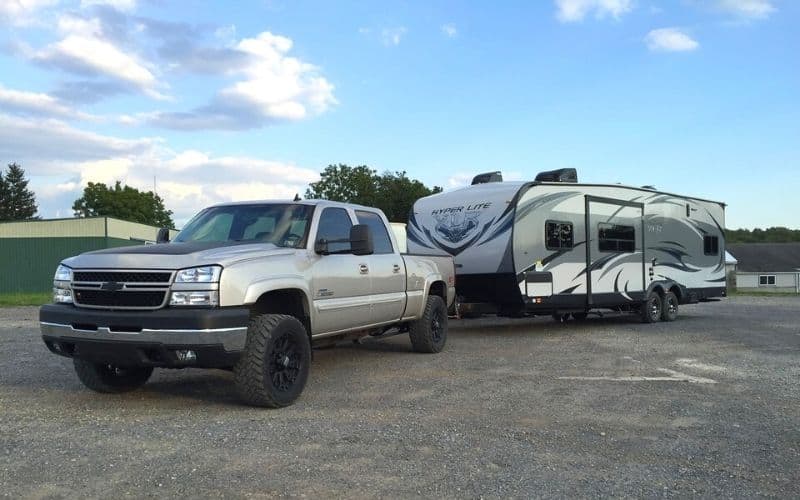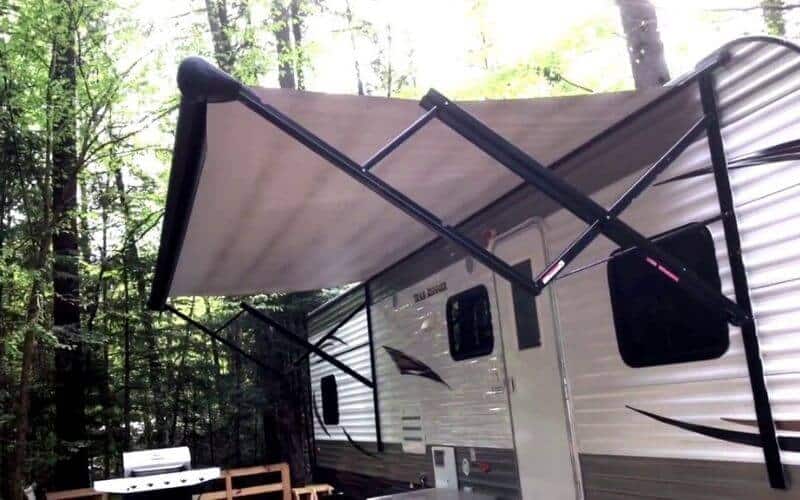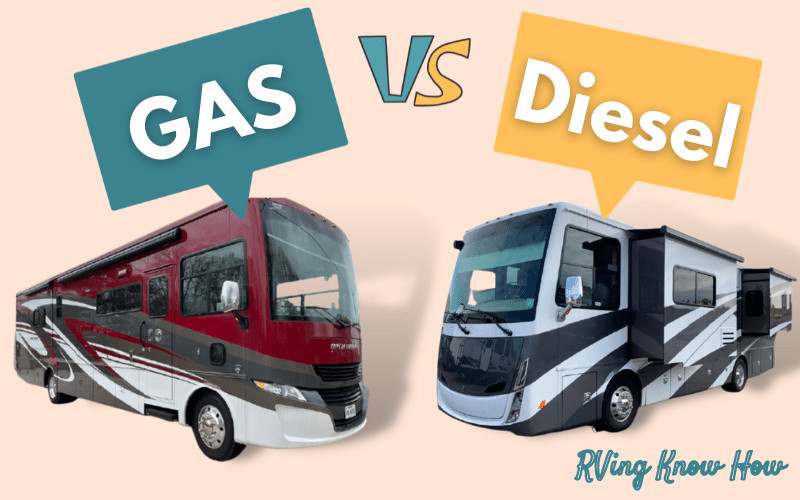The average cost to store an RV is around $130 monthly. However, prices range anywhere between $50 and $450 per month, depending on your area, the size of your RV, and the storage amenities you want.
According to Storage.com, a browse-and-compare website for renting and reserving self-storage units, an outdoor storage spot with no covering can cost $30 to $100 monthly, while a non-climate-controlled indoor storage unit may cost $50 to $125 monthly.
Having lived the RV lifestyle for a decade and counting, I have noticed that storage is a huge challenge for many new RVers, especially those who can’t store it where they live. In this article, you will learn all the relevant details about storing your camper, including the price to expect and the best storage options to go for based on your needs.
What Affects RV Storage Costs?

Credit: John Marruci
The location where your RV is parked, the amenities you want, and the type and size of your RV are the significant factors that will ultimately determine how much it will cost you to store the unit.
With an understanding of how these factors work, you will know the price range to expect. Let’s look into them in detail:
1. Your Location
How much it costs to store an RV varies from state to state. In popular areas such as Arizona, where I’m currently based, the cost is higher due to increased demand.
For example, I spent $940 for outdoor storage of my Winnebago Journey Class A for six months using Southwest RV storage service in Glendale.
However, in less-traveled areas such as Alaska, you can find much cheaper rates. Some RVers have disclosed on forums that they spend $600 for eight months in a heated facility in those areas.
2. Your RV Type and Size
Many RV storage facilities, especially those with indoor options, base their rates on the size and type of unit.
That is, if your camper requires less room at their facility, you will end up paying less money. The storage size available for smaller rigs at many facilities typically measures 10’ x 25’ and 10’ x 30’.
Here’s a rundown of rig sizes and how they influence the storage size you’ll need:
- Smaller rigs: If you have the 2021 Lance Camper 1050S, Class B’s (2011 Roadtrek 190 Popular), or a small travel trailer (fiberglass Scamps and Casitas), then your rig will fit into the dimensions mentioned above.
- Mid-size motorhomes: If you’re in a 30’ rig such as the 2012 Forest River Cherokee or 2011 Fleetwood Tioga, you will want a space 35’ long or more.
- Large travel trailer: Motorhomes of 35’ or more will need a 40 to 50-foot space at any indoor storage facility. Class A’s are the tallest of all the RVs and, therefore, will require a height clearance of around 14’ or more.
Pro Tip:
- Storing a larger rig will put you at the higher end of the price range, while a smaller rig will put you on the lower end of the price range.
3. Storage Amenities
The extra perks that come with a storage service can also influence the price.
In cold climates, such as New England and the Midwest, consider choosing a heated storage facility.
It will cost more monthly, but you won’t have to worry about winterizing your rig like you would if it were parked outside in the snow. In more mild climates, an outdoor area is fine.
The table below presents a breakdown of the amenities and their respective RV storage cost:
| RV Storage Amenities | Details | Average Costs |
|---|---|---|
| Outdoor, uncovered | The price range for a basic spot to park your RV without any perks around (some have a locked gate) | $50 – $80 monthly. |
| Outdoor, covered | Storage space with a carport-style cover outside | $100 – $159 monthly. |
| Enclosed | Your RV will be inside a facility. You may have a private garage-like spot, or your rig may be within an indoor lot among other campers and boats. | $200 – $300 monthly. |
| Enclosed, heated, and climate-controlled | Offers security, protection against weather, humidity, and pests, and possibly servicing of the rig. | Around the $400 price range |
Some full-service RV storage facilities allow RV owners to purchase their RV storage, offering a one-off payment instead of a monthly payment. Luxtorvip.com in Coachella and Prescott is an excellent example, where the sales of space start at $180,600.
4. Lease Terms
The length of your storage agreement can affect the cost. Some facilities offer discounts for long-term commitments, while others may charge higher rates for short-term rentals.
For example, Southwest RV storage services charges $154 monthly for storing a 40’ RV. But if you pay for a year upfront, you’ll be charged $1,663, which means you’re saving $185 due to lease terms.
Many other storage services condition their prices based on lease terms and the number of monthly payments covered upfront.
5. Demand and Seasonal Factors
You can expect prices to be higher during peak RV usage seasons or in areas with limited storage availability.
In summer, when more people use their RVs for vacations, storage prices may go up. Winter sees higher demand in colder places for protection against snow.
However, off-peak seasons, like fall or spring, might have lower prices.
Now that you know the factors that can influence how much you pay to store your RV let’s look at the differences between RV storage costs.
RV Storage Costs – Comparison
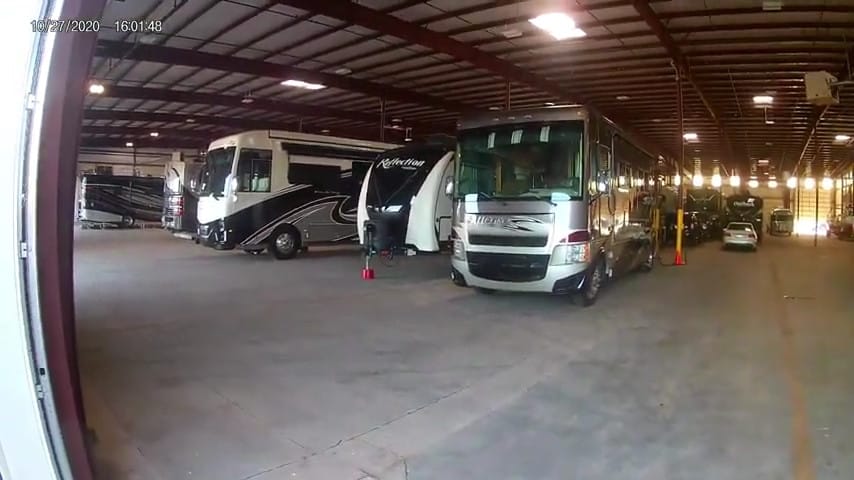
Credit: Country Coach Guy
After combing through the price list of twenty popular RV storage facilities in different states, I’m able to come up with this basic price guide, which factors the size of storage that’s needed.
Remember, these prices vary depending on where the storage facility is located.
| RV Dimensions | Description | Average Monthly Price for Basic Indoor Storage | Average Monthly Price for Climate-Controlled Storage |
|---|---|---|---|
| 10’ x 25’ | Small travel trailers, vans, and truck campers under 25’ long | $180 | $225 |
| 10’ x 30’ | Class B’s and travel trailers under 30’ long | $250 | $300 |
| 14’ x 35’ | Class C’s, fifth wheels, travel trailers, and small class A’s under 35’ long | $300+ | $400+ |
| 14’ x 40’ | Class A’s, fifth wheels, and travel trailers under 40’ long | $350+ | $450+ |
| 14’ x 50’ | Class A’s and Fifth wheels under 50’ long | $400+ | $450+ |
Pro Tips:
- The more perks of storage you want, the more money you should be prepared to spend.
- A heated indoor storage facility is the best option since you won’t have to worry about pipes freezing or rodents moving in.
- If your camper is going to stay outside and uncovered, I recommend you invest in an RV cover, wheel covers, and possibly chocks to keep the tires off the ground.
Where Can I Store My RV?
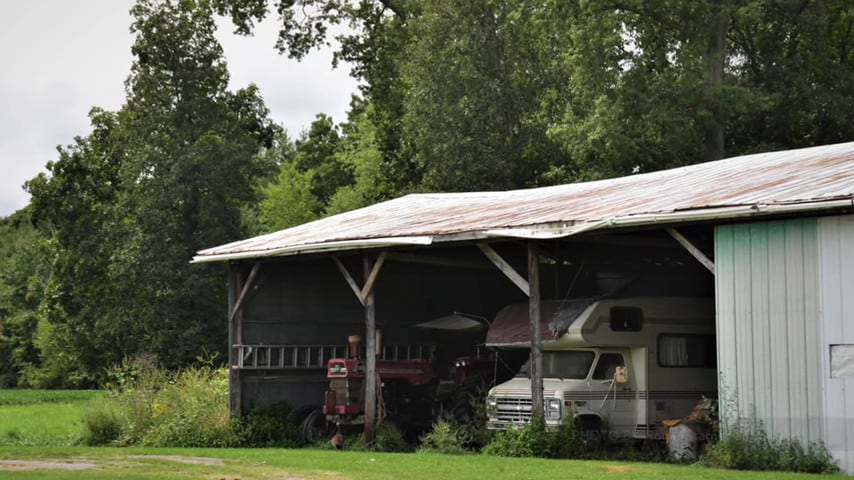
Credit: John Marucci
There are many options for storing RVs, but your decision will depend on security, accessibility, and cost. Here are several options for RV storage:
1. Home Storage
If you have sufficient space on your property, you can store your RV in your driveway or yard. If your garage is large enough, that’s another viable option, especially to protect the rig from the elements.
However, you have to check local regulations and homeowner association rules, as some areas have restrictions.
Pros
- Convenient and accessible
- There is no additional cost if you have enough space on your property.
Cons
- Some neighborhoods or local regulations may restrict RV storage on residential properties.
- Exposure to the elements unless covered
- Theft risk from outsiders.
2. RV Storage Facilities
Many facilities offer open-air parking spaces. Some storage facilities offer covered storage that will protect your rig from sun and weather. As you’ve seen in the previous section of this post, indoor storage options are more expensive.
You can find the one closest to you by simply searching “RV storage facility near me” on Google.
Pros
- Dedicated facilities with security measures
- They often have amenities like electricity, dump stations, and wash areas.
Cons
- Monthly rental fees
- It may not be as conveniently located as stored at home.
3. Self-storage Units
Some self-storage facilities offer larger units suitable for RV storage. Similar to RV storage facilities, some of these sites provide outdoor parking spaces for RVs.
I like this option, especially when I consider the flexibility in the lease terms and duration process. In most of these sites, you can choose the duration of storage based on your needs.
Pros
- Flexible lease terms and duration options
- Various unit sizes to accommodate different storage needs
- Security features like surveillance and gated access
- No long-term commitment required
Cons
- Lack of on-site assistance for tasks like loading
4. Campgrounds
If you frequently use a particular campground, keeping your RV there eliminates the need to transport it back and forth, saving time and effort.
Some campgrounds offer seasonal storage for RVs. This can be convenient if you plan to use your RV during certain times of the year.
Pros
- Convenient for frequent visitors to a particular campground
- Access to campground amenities and possibly on-site staff
- Proximity to camping sites for easy trip preparation
Cons
- Limited availability of storage spaces.
- Additional cost on top of camping fees
- Security measures may not be as extensive as dedicated storage facilities
5. RV Dealerships
Some RV dealerships offer storage services for their customers. This can be convenient if you purchase your RV from them.
You may get free storage service for a year in their facility.
The best part of this option is that you have easy access to to the service department if your RV needs maintenance or repair.
However, in many cases, access to your RV may be restricted to the dealership’s business hours.
Pros
- Easy access to storage at the place you purchase your RV
- Dealerships may understand the specific needs of the RV models they sell.
- Convenient access to maintenance and repair services if needed
- Storage service can be accessible for a duration if you purchased from the dealer
Cons
- Limited space may be available.
- Access to your RV may be restricted to the dealership’s business hours
- Not all RV dealerships provide storage service.
What Is The Cheapest Place To Store an RV?
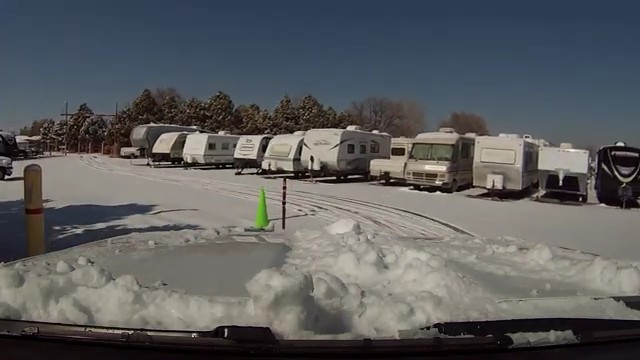
Credit: Colorado Camperman
Home storage is the cheapest option to store an RV because you don’t need to pay for it.
However, not everyone would prefer to keep a rig in the neighborhood due to theft risk, exposure to elements, or neighbors’ inconvenience, especially if there are two or more campers.
In that case, the next cheapest place worth considering is any self-storage facility nearby. These facilities usually have convenient, cost-effective RV and boat storage solutions with lower costs than most dedicated RV storage locations.
What RV storage option do you think suits you best and why? I’d love to hear your thoughts in the comments below.


